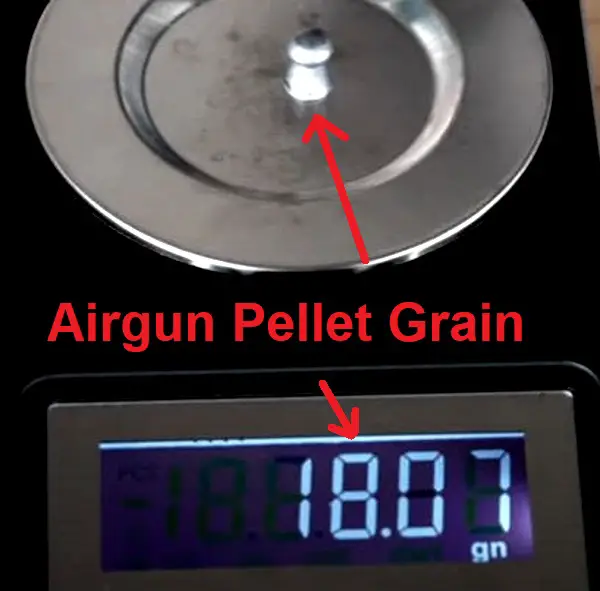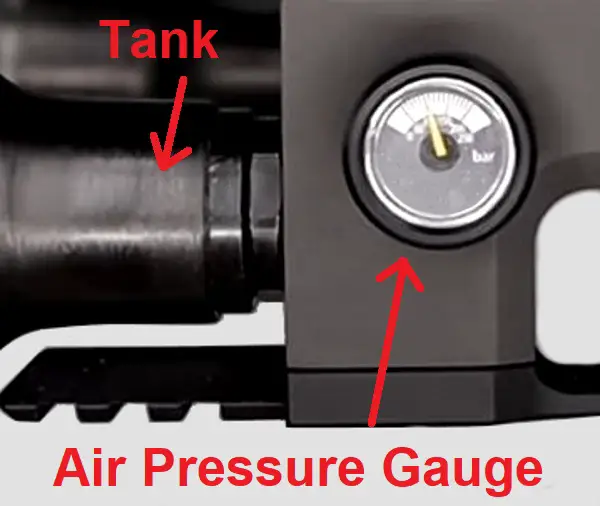Air guns fire projectiles at certain speeds and distances, and this is what partly separates them from other types of firearms. Knowing the ballistics of the air gun you are firing can help you adjust your aim and hit the target successfully.
Air Rifle Ballistics
The term ‘ballistics’ refers to the science of the motion of objects in flight, which is affected by the projectile’s physical characteristics.
The ballistics of air rifles is partly what makes them so popular for hunting, target shooting, and airsoft sports.
Air rifles use compressed air or C02 to fire pellets or BBs. The amount of air pressure released during firing affects the ballistics of the airgun. The shape and material of the bb or pellet also affect the air rifle’s ballistics.
The more you understand your air gun’s ballistics, the better you will be able to predict how a pellet will travel after it leaves the barrel.
Air Gun Ballistics Table
The following table shows the ballistics of airgun pellet caliber sizes:
| Projectile | Caliber | Section Density | Weight (grains) | Ballistic Coefficient | Form Factor | Muzzle Velocity | 30 Yard Velocity |
| Pellet | .177 | ~.038 | ~8 | ~0.012 | ~3 | ~900 FPS | ~750 FPS |
| Pellet | .22 | ~0.042 | ~14.5 | ~0.02 | ~2 | ~900 FPS | ~750 FPS |
| Pellet | .25 | ~0.05 | ~25.0 | ~.024 | ~2.00 | ~800 FPS | ~700 FPS |
| Pellet | .30 | ~0.75 | ~48.00 | ~0.045 | ~1.75 | ~700 FPS | ~650 FPS |
The table headings are defined as:
Caliber = The diameter of the air gun barrel.
Section Density = Section density ties directly into the pellet’s penetration ability. The higher the sectional density, the better the pellet’s ability to penetrate targets.
Weight (grains) = The pellet or bb’s weight. Each grain is equal to 0.0648 grams. An 8-grain pellet will weigh .051 grams and a 48-grain pellet will weigh 3.11 grams. Pellet grains can be found on the box or label, or measured using a measuring scale, as seen below.
Ballistic Coefficient = This measures a projectile’s ability to withstand air resistance in flight. The higher this number, the less it will be slowed down by its mass.
Form Factor = This shows the effects of the pellet’s design.
Muzzle Velocity = The speed at which a pellet or bb exits the barrel of the airgun. It is usually measured in feet per second (fps) or meters per second (m/s). Muzzle velocity can have a significant impact on the accuracy, range, and terminal ballistics of the pellet.

Air Gun Pellet Velocity
Air gun pellet velocity plays a significant role in affecting its trajectory and impact. However, most air gun manufacturers embellish the velocity by using a very light pellet under controlled circumstances. So, shooters should keep this in mind when shooting an air gun outdoors and adjust their range accordingly.
Airgun velocity also directly affects its overall power. If you would like to learn more about this, see our post The Most Powerful Air Guns.
Air Gun Pellet Trajectory
To get a better idea of the trajectory of your pellet gun, check its ballistic coefficient. The ballistic coefficient is what measures a pellet’s ability to maintain its velocity while traveling through the air.
Air gun pellets and bbs are more susceptible to being redirected off course by wind pressure. The trajectory will have more curvature than ordinary rifle rounds. This means that the farther away from the target, the less likely the pellet or bb will get there.
Air gun ammunition does not have the same force propelling them as those used in regular gunpowder rifles, nor do they have the same aerodynamic designs. This means they lose their velocity more quickly and their trajectory suffers as a result.
Air Gun Air Pressure
Air gun air pressure refers to the amount of compressed air that is contained within the air reservoir or cylinder of an air gun. Air pressure is what pushes the pellet or BB out of the airgun barrel. The air pressure in an air gun is usually measured in either pounds per square inch (PSI) or bar (a metric unit of pressure).
The air pressure in an air gun is a critical factor in determining the performance of the gun. Generally, the higher the air pressure, the greater the velocity of the projectile and the greater the accuracy and range of the gun. However, there are limits to how high the air pressure can be, as too high a pressure can damage the gun or cause it to be unsafe to use.

A C02 air gun will have pressurized air stored in a small tank attached to it. If this gets too low, the air pressure will not be as powerful and the ballistics will suffer. At this point, the C02 tank will need to be refilled or replaced with a full one. Air guns can also be recharged using a high-pressure hand pump that compresses air into an internal cylinder.
The recommended air pressure for a particular air gun will depend on the specific make and model of the gun, as well as the type of ammunition being used. It is important to follow the manufacturer’s recommendations for air pressure to ensure safe and effective use of the gun.
The pressure of an airgun can also affect the level of sound produced when it is fired. For more on this, see our post How Quiet Are Air Guns?
Air Gun Calibers
Air gun calibers refer to the diameter of the projectile or pellet used in an air gun. Air guns are available in a range of calibers, with .177, .22, .25, and .30 being the most popular choices.
- The .177 caliber is the most popular air gun caliber and is commonly used for target shooting and pest control. It is a small, lightweight pellet that is highly accurate and travels at a high velocity.
- The .22 caliber is also a popular choice for air gun enthusiasts and is commonly used for hunting small game. It is a slightly larger pellet than the .177 caliber and therefore has more stopping power.
- The .25 caliber is a relatively new addition to the air gun market and is becoming increasingly popular for hunting and target shooting. It is a larger and heavier pellet than the .22 caliber and has greater accuracy and power at longer distances.
- The .30 caliber is the largest caliber commonly used in air guns and is primarily used for hunting large game. It is a heavy, hard-hitting pellet that is capable of taking down small to medium-sized games at longer distances.
When choosing an air gun caliber, it is important to consider the intended use of the gun, as well as the availability and cost of ammunition.
Air Gun Range
Air guns have a fairly limited range in comparison to ordinary rifles. If a shooter tries to reach beyond the effective range of an air gun, they will be disappointed. Air gun pellets lose their velocity after a certain point and may be unable to penetrate the target.
Typically, airgun pellets have a range of around 100-150 yards (91-137 meters) for .177 caliber pellets, up to 250-300 yards (229-274 meters) for .22 caliber pellets, and up to 400 yards (366 meters) for larger calibers like .25 and .30.
However, the effective range of an airgun pellet for accurate shooting is typically much less than its maximum range. This is because as the pellet travels further, it loses velocity and energy, which can cause it to drop or be affected by wind or other external factors.
The effective range for accurate shooting with an airgun pellet can vary depending on the power and accuracy of the airgun, as well as the skill of the shooter.
Air Gun Barrel Length
The barrel length of an air gun refers to the distance from the breech (where the pellet is loaded) to the muzzle (the end of the barrel where the pellet exits). The length of the barrel can affect the velocity, accuracy, and power of the air gun, as well as the noise level and overall size and weight of the gun.
Long Vs. Short Air Gun Barrel Length
Generally, a longer barrel can provide greater accuracy and power, as it allows more time for the air pressure to accelerate the pellet and also helps to stabilize the pellet in flight.
However, a longer barrel can also make the gun heavier and more difficult to handle and may be more cumbersome for certain types of shooting, such as close-range target shooting or hunting in dense brush.
A longer barrel is mostly better for aiming as it gives the shooter a more weighted balance due to increased length. Longer barrels are good at enhancing ballistics on ordinary hunting rifles that fire gun powder, instead of compressed air.
On the other hand, a shorter barrel can be more compact and easier to handle and may be better suited for certain types of shooting, such as quick-draw target shooting or hunting in tight spaces. However, a shorter barrel may sacrifice some accuracy and power, as there is less time for the air pressure to accelerate the pellet and stabilize it in flight.
The optimal barrel length for an air gun will depend on the specific make and model of the gun, as well as the intended use and personal preferences of the shooter. It is important to consider the trade-offs between accuracy, power, and maneuverability when choosing an air gun with a specific barrel length.
To Close
While air guns are in no way as powerful as ordinary gunpowder pistols and rifles, they still pack a punch and can hurt a person or animal. This is why it is important to never underestimate the risk of injury while shooting them and always keep safety in mind.
- RWS Air Gun Shooter’s Gun Cleaning Kit and Targets Review - July 26, 2023
- Motanar .177/.22 4.5mm/5.5mm Air Rifle Barrel Cleaning Kit Review - July 26, 2023
- Raiseek .177 Cal & .22 Cal Airgun Cleaning Kit Review - July 26, 2023

